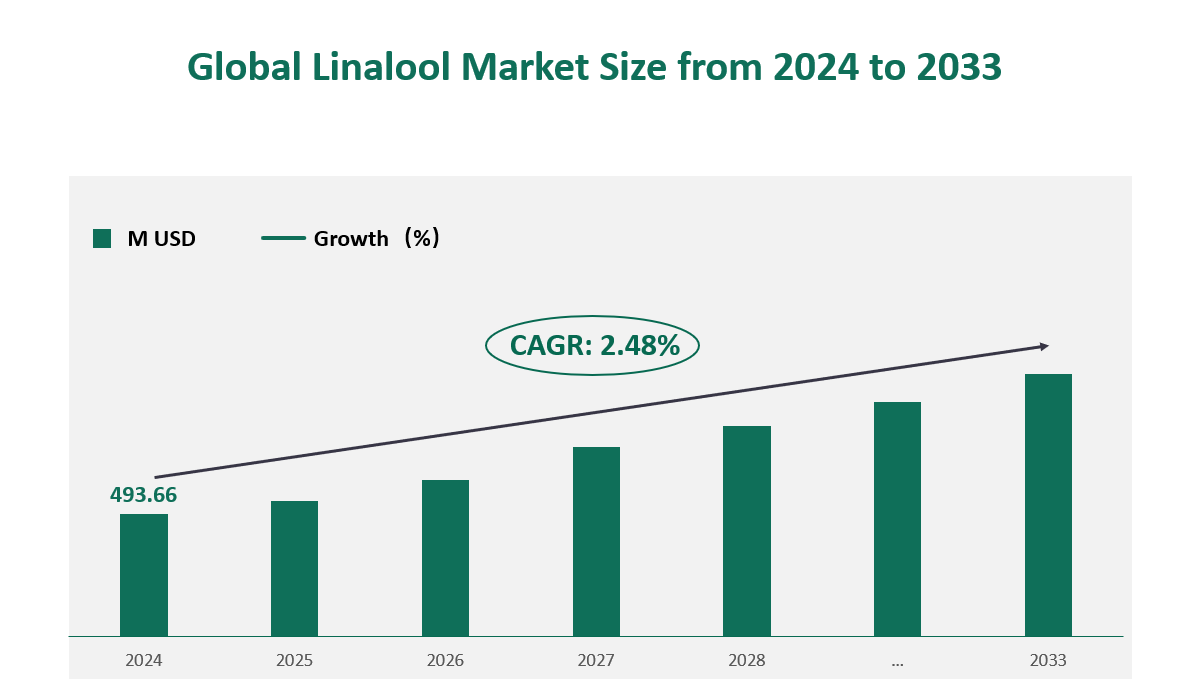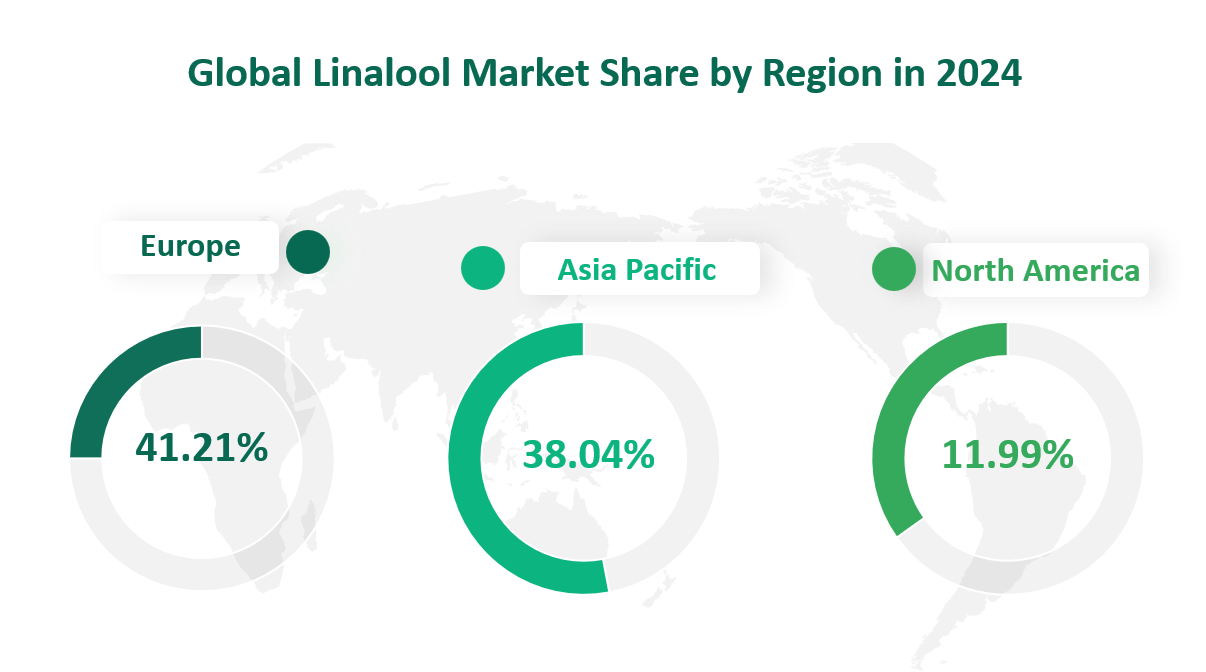1 Global Linalool Market Size (Revenue) and CAGR (2024-2033)
Global Linalool market generated revenue of USD 493.66 Million in 2024 with a CAGR of 2.48% during 2024 to 2033.
The current situation of the Linalool market, as of 2024, shows a steady growth trajectory. The market has been expanding due to the increasing demand from downstream industries such as flavors and fragrances, cosmetics, and pharmaceuticals. The growth is also attributed to the rising awareness of natural and synthetic Linalool’s applications in various consumer products.
The market is characterized by a high concentration of a few major players, with BASF, NHU, and Millennium Specialty Chemicals Inc holding significant market shares. These companies have been investing in research and development to improve product quality and explore new applications, which has contributed to the market’s growth.
However, the market also faces challenges such as rising production costs due to increased energy prices and the need for compliance with stricter environmental regulations. Despite these challenges, the market is expected to continue growing at a CAGR of 2.48% from 2024 to 2033. This growth is anticipated to be driven by the ongoing demand from the fragrance and flavor industry, as well as the potential for new applications in the healthcare sector.
Figure Global Linalool Market Size (M USD) Outlook (2024-2033)

2 Linalool Market Trends
Table Market Trends
Trends | |
The trend of reducing production costs and intensifying market competition | Linalool is a fine chemical product with high added value. The downstream of the linalool industry is mainly used in the fields of flavors and fragrances, chemical industry, medicine and so on. There are a large number of flavor and fragrance enterprises. With the advancement of industrial integration, the industry may present an all-round competitive situation in terms of scale, technology, and financial strength. The linalool market is increasingly competitive. In addition, large companies in the industry are committed to further improving the technological level, improving the advantages of the industrial chain, reducing production costs and improving the competitiveness of enterprises. |
3 Global Linalool Market by Type in 2024
Linalool, a terpenoid alcohol found naturally in various plants, flowers, and spices, is a key ingredient in numerous industries due to its fragrance and flavor properties. The market for Linalool is segmented into two primary product types: Natural Linalool and Synthetic Linalool. Each type has distinct characteristics and market dynamics.
Natural Linalool is derived from plant sources and is obtained through extraction and separation processes. It is highly valued for its natural origin and is used in applications where natural ingredients are preferred. In 2024, the market size for Natural Linalool was 1257 tons, with a revenue of 42.01 M USD. The market share of Natural Linalool in 2024 was 8.51%, reflecting its niche but growing presence in the market.
Synthetic Linalool, on the other hand, is produced through chemical synthesis. It is widely used due to its consistency in quality and lower production costs compared to natural Linalool. In 2024, Synthetic Linalool had a market size of 28879 tons and a revenue of 451.66 M USD. Its market share was 91.49%, making it the dominant product type in the Linalool market.
In terms of growth rates, Natural Linalool showed a faster growth rate with a CAGR of 4.05% from 2024 to 2033, compared to Synthetic Linalool’s CAGR of 2.34% over the same period. This indicates that while Synthetic Linalool currently holds the largest market share, Natural Linalool is experiencing a more rapid expansion, potentially due to increasing consumer preference for natural ingredients in personal care and food products.
Table Global Linalool Market Size and Share by Type in 2024
Type | Market Size (Tons) | Revenue (M USD) | Market Share (%) |
|---|---|---|---|
Natural Linalool | 1257 | 42.01 | 8.51 |
Synthetic Linalool | 28879 | 451.66 | 91.49 |
Total | 30136 | 493.66 | 100.00 |
4 Global Linalool Market by Application in 2024
Linalool finds extensive application across various industries, primarily in fragrances, flavors, and other miscellaneous uses. Each application area has unique requirements and market dynamics that influence the demand for Linalool.
Fragrance is the largest application area for Linalool, where it is used to create a wide range of scents in perfumes, cosmetics, and household products. In 2024, the fragrance application had a market size of 20489 tons and a revenue of 325.87 M USD. It held a significant market share of 66.01%, reflecting its critical role in the fragrance industry. The growth rate of the fragrance application was 2.18% from 2024 to 2033, indicating a steady demand driven by the continuous expansion of the personal care and home fragrance markets.
Flavor is another significant application, where Linalool is used to enhance the taste of food and beverages. In 2024, the flavor application had a market size of 6856 tons and a revenue of 116.50 M USD, with a market share of 23.60%. The flavor application showed a slightly higher growth rate of 2.76% from 2024 to 2033, suggesting a growing demand for flavored products in the food and beverage industry.
In conclusion, while the fragrance application currently holds the largest market share, the flavor application is growing at a slightly faster rate. The market dynamics suggest that Linalool will continue to be a valuable ingredient across multiple sectors, driven by both traditional and emerging applications.
Table Global Linalool Market Size and Share by Application in 2024
Application | Market Size (Tons) | Revenue (M USD) | Market Share (%) |
|---|---|---|---|
Fragrance | 20489 | 325.87 | 66.01% |
Flavor | 6856 | 116.50 | 23.60% |
Others | 2791 | 51.29 | 10.39% |
Total | 30136 | 493.66 | 100.00% |
5 Global Linalool Market by Region in 2024
The global Linalool market is distributed across several key regions, each contributing uniquely to the overall market dynamics. In 2024, the market sizes and shares varied significantly among these regions, reflecting different levels of industrial development, consumer demand, and regulatory environments.
Asia-Pacific emerged as the largest regional market by revenue, with a substantial share of 187.81 M USD. This region’s dominance can be attributed to its vast consumer base, rapid industrialization, and growing demand for personal care and fragrance products. Countries like China and India played pivotal roles, with China alone accounting for a significant portion of the regional revenue due to its extensive manufacturing base and domestic market consumption.
Europe followed closely, with a revenue of 203.43 M USD. The region’s strong presence in the fragrance and flavor industries, coupled with a high demand for premium personal care products, contributed to its significant market share. Europe’s market was characterized by a mature consumer base and a preference for high-quality, natural ingredients, which aligned well with the growing trend towards natural Linalool.
North America had a revenue of 59.18 M USD in 2024. The region’s market was driven by a robust personal care and cosmetics industry, with a particular focus on innovation and product differentiation. The United States and Canada were the main contributors, with the U.S. market being particularly influential due to its large consumer market and advanced research and development capabilities.
Latin America had a revenue of 24.92 M USD. The region’s market growth was fueled by increasing urbanization and a rising middle class, which led to higher demand for personal care and fragrance products. Brazil and Mexico were the leading countries in this region, with Brazil contributing significantly to the regional revenue due to its large population and growing economy.
Middle East and Africa had a revenue of 18.33 M USD. The region’s market was characterized by a growing demand for luxury personal care products and a preference for natural ingredients. Turkey, Saudi Arabia, and the UAE were the key markets, with Turkey contributing a significant portion due to its strategic location and growing manufacturing capabilities.
In terms of growth rates, Asia-Pacific was the fastest-growing region with a CAGR of 3.86% from 2024 to 2033. This rapid growth was driven by the region’s economic expansion, increasing disposable incomes, and a growing awareness of personal care and fragrance products. The region’s large and expanding middle class, particularly in countries like China and India, was a significant factor in driving demand.
Table Global Linalool Market Size, Region Wise in 2024
Region | Market Size (M USD) | Market Share (%) |
|---|---|---|
North America | 59.18 | 11.99% |
Europe | 203.43 | 41.21% |
Asia-Pacific | 187.81 | 38.04% |
Latin America | 24.92 | 5.05% |
Middle East & Africa | 18.33 | 3.71% |
Total | 493.66 | 100.00% |
Figure Global Linalool Revenue Market Share by Region in 2024

6 Global Linalool Market Top 3 Players
Company Introduction and Business Overview: BASF is a leading global chemical company with a diverse product portfolio. Established in 1965, the company operates in six segments, including chemicals, plastics, performance products, functional solutions, agricultural solutions, and oil and gas. BASF’s global presence and extensive distribution network make it a dominant player in the Linalool market.
Products Offered: BASF offers a wide range of Linalool products, including both natural and synthetic variants. Its Linalool products are used in various applications such as fragrances, flavors, and personal care products. The company is known for its high-quality and consistent products, which are preferred by many downstream industries.
Revenue in 2022: In 2022, BASF’s revenue from Linalool was 140.87 M USD. The company’s strong market position and continuous investment in research and development have helped it maintain a significant share of the market.
Company Introduction and Business Overview: NHU is a major player in the functional chemicals market, focusing on the research and development, production, sales, and service of nutritional products, fragrances, and polymer materials. Established in 1999, the company has a strong presence in America, Europe, and Asia, providing comprehensive solutions for various industries.
Products Offered: NHU offers a variety of Linalool products, with a particular emphasis on natural Linalool. Its products are used in functional flavors, fruit flavors, and as raw materials for synthesizing other compounds. The company’s patented technology and cost advantages have helped it gain a significant market share.
Revenue in 2022: In 2022, NHU’s revenue from Linalool was 134.59 M USD. The company’s strong market penetration and continuous innovation have allowed it to compete effectively in the global market.
Millennium Specialty Chemicals Inc
Company Introduction and Business Overview: Millennium Specialty Chemicals Inc is an international chemical company with a broad range of commodity, industrial, performance, and specialty chemicals. Established in 2009, the company has a strong market presence in America, Europe, and the Middle East, serving various industries with its high-quality products.
Products Offered: Millennium Specialty Chemicals Inc offers a variety of Linalool products, including (-)-Linalool. The company’s products are used in fragrances, flavors, and other industrial applications. Its complete industrial facilities and upstream industry chain advantages have helped it maintain a strong market position.
Revenue in2022: Millennium Specialty Chemicals Inc’s revenue from Linalool was 68.66 M USD. The company’s focus on market share and continuous improvement in production processes have contributed to its success in the Linalool market.
Table Global Linalool Revenue Share of Top3 Players in 2022
Company | 2022 |
BASF | 31.17% |
NHU | 29.78% |
Millennium Specialty Chemicals Inc | 15.19% |

